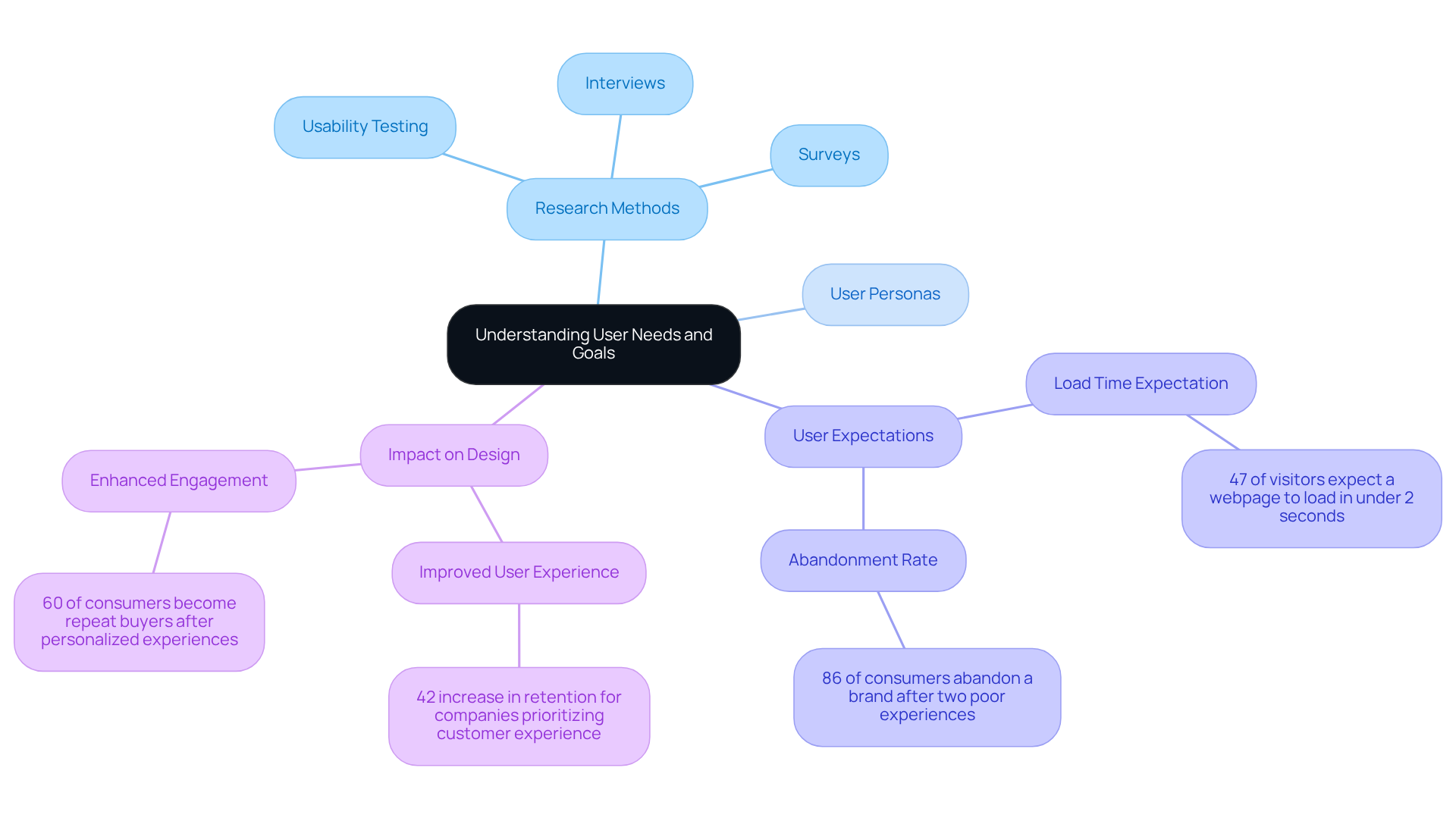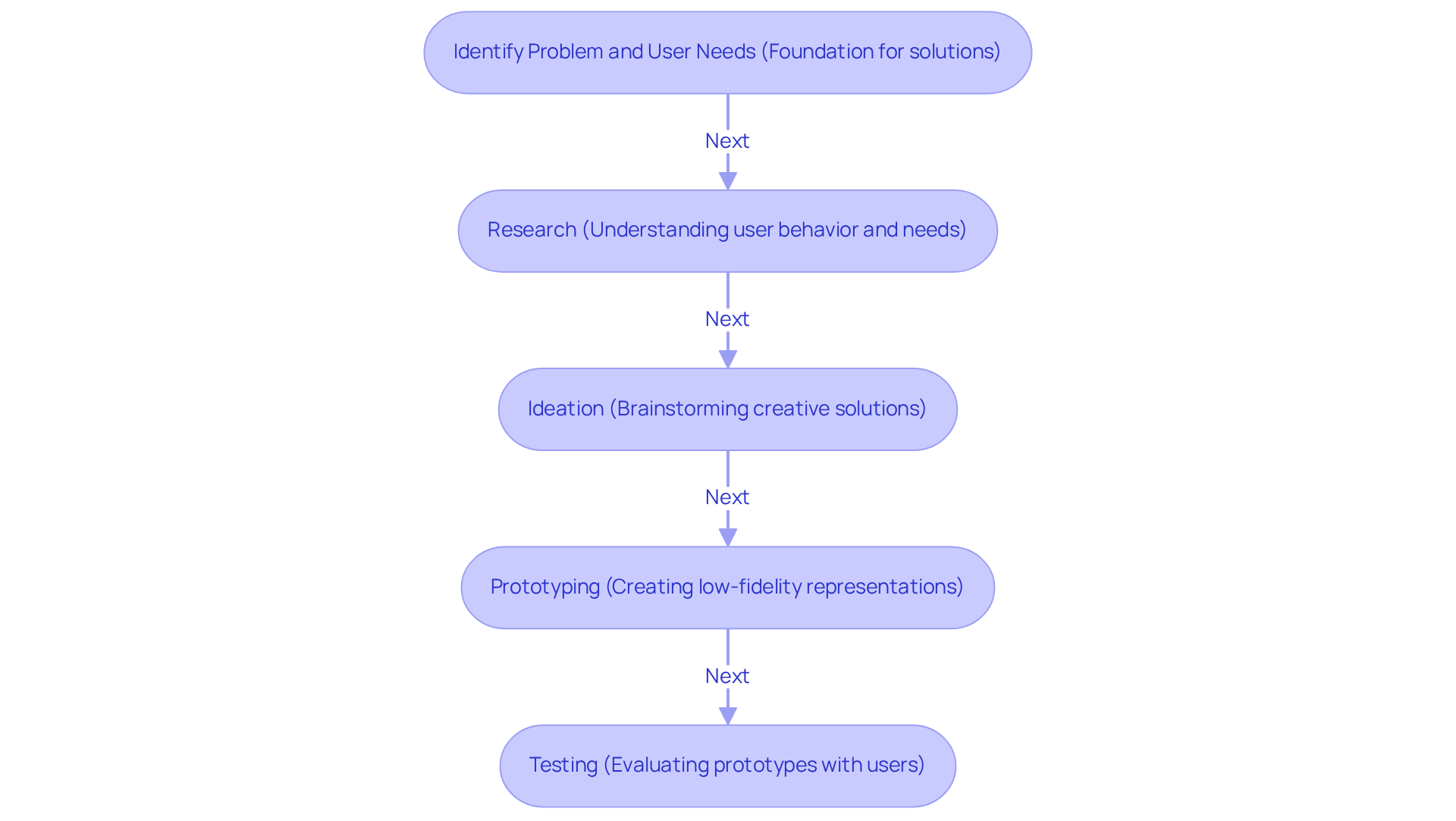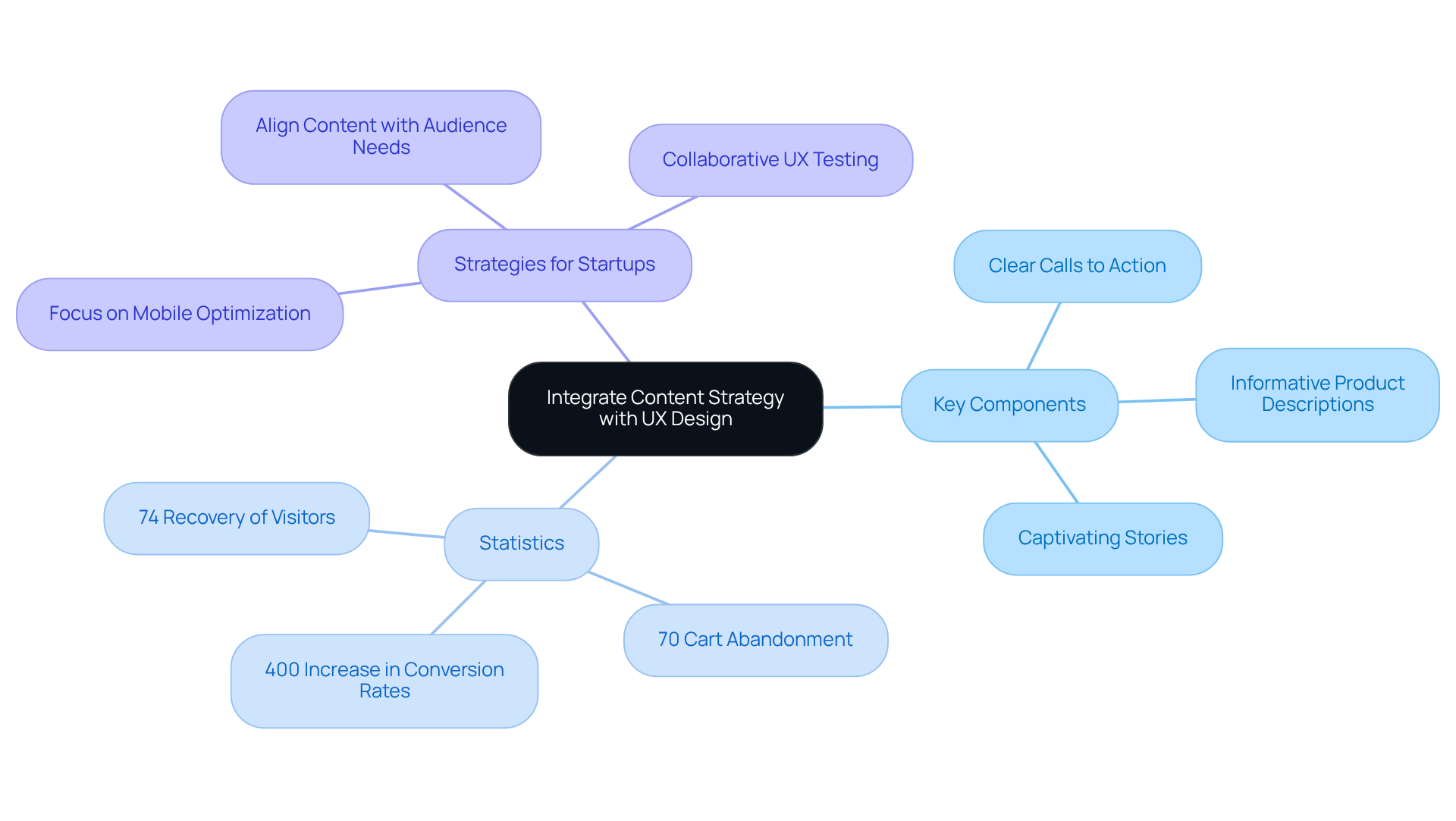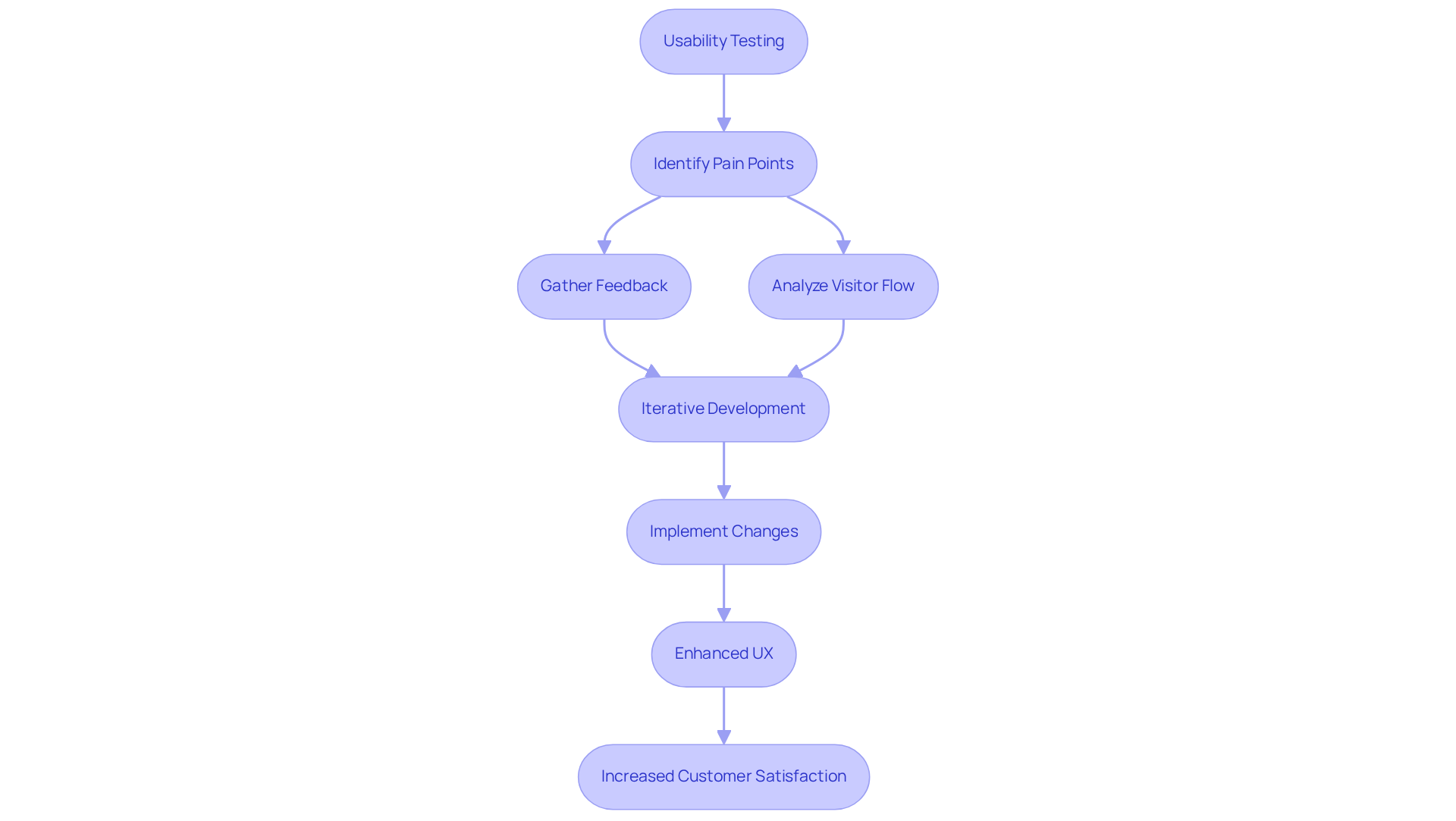Overview
In the journey of building a startup, one of the most pressing challenges is creating an effective user experience (UX) in web design. Many founders find themselves overwhelmed by the myriad of choices and the pressure to succeed. This struggle can lead to frustration, especially when user needs are overlooked, resulting in a disconnect that can hinder growth and customer satisfaction.
Understanding user needs is crucial; it’s the foundation of a successful design. When startups take the time to listen and empathize with their users, they can create experiences that resonate deeply. Implementing a structured design process further alleviates the chaos, providing a clear path forward. By integrating a thoughtful content strategy, startups can ensure that their message is not only heard but also felt by their audience.
Moreover, emphasizing testing and iteration is essential. It’s a nurturing approach that allows for continuous improvement, fostering a culture of learning and adaptation. Each of these practices is supported by evidence and examples, illustrating how a user-centered approach can enhance customer satisfaction and improve conversion rates. By adopting these best practices, startups can navigate the competitive landscape with confidence, knowing they are supported by a community that understands their journey. Together, we can guide these passionate founders toward success.
Introduction
Crafting an effective user experience (UX) can feel like a daunting challenge for startups trying to find their footing in the competitive digital landscape. It’s essential to truly understand user needs and to weave a structured design process into your approach. Doing so can significantly enhance engagement and retention, ultimately paving the way toward success.
Yet, many startups find themselves struggling to align their UX strategies with content and iterative testing. This misalignment can lead to missed opportunities for improvement, leaving founders feeling frustrated and overwhelmed.
What if there were best practices that could empower these fledgling companies to create a seamless and impactful web experience? Together, we can explore these strategies and foster a brighter path forward for your startup.
Understand User Needs and Goals
To create a successful experience for clients, new companies often face the challenge of truly understanding their audience's needs and objectives. This can feel overwhelming, but it's essential. Conducting thorough participant research through methods such as surveys, interviews, and usability testing can illuminate these needs. By gathering both qualitative and quantitative information, new businesses can craft personas that genuinely reflect their target audience. These personas become vital tools for visualizing motivations, pain points, and desired outcomes, guiding creative decisions with compassion and clarity.
For example, a tech startup might learn that its clients prioritize speed and efficiency. This insight can lead to a design that minimizes loading times and simplifies navigation. Considering that 47% of visitors expect a webpage to load in under two seconds, it’s crucial to meet these expectations to keep individuals engaged. Moreover, the reality is that 86% of consumers will abandon a reliable brand after just two unsatisfactory experiences, underscoring the importance of truly understanding client expectations.
Regularly reviewing and refreshing these profiles ensures that the design remains relevant as needs evolve, ultimately enhancing client satisfaction and engagement. In fact, companies that prioritize customer experience see an average 42% increase in retention, highlighting the importance of a user-centered approach in UX. As noted by UX specialists, 'Understanding the needs of individuals is not just beneficial; it’s essential for sustained success in the digital landscape.' This journey of empathy and understanding is not just about meeting expectations—it's about nurturing lasting relationships with clients.

Implement a Structured UX Design Process
Startups often face the daunting challenge of establishing an effective UX for the web development process. This struggle can lead to frustration and costly mistakes. However, by adopting a structured approach that encompasses stages such as research, ideation, prototyping, and testing, startups can navigate these challenges more effectively. It all begins with identifying the problem and understanding the needs of users—an essential step that lays the foundation for meaningful solutions. From there, brainstorming possible ideas can ignite creativity and innovation.
Prototyping plays a crucial role in this journey, allowing teams to create low-fidelity representations of their concepts. These prototypes can then be evaluated with real users, gathering invaluable feedback that informs design decisions. This iterative process not only refines the design but also minimizes the risk of expensive changes later in development. For example, a new company might leverage wireframes to visualize their app's layout, helping them spot usability issues early on—before they commit to full-scale development.
Documenting each stage is equally important, as it ensures that all insights are captured and can be utilized in future iterations. As Frosina Stojchevska wisely states, "UX is not a 'set and forget' element; it’s best treated as an ongoing process." Investing in UX is not just a cost; it can yield significant returns, with every dollar spent potentially bringing between $2 and $100 in return. Yet, it’s vital for new ventures to be aware of common pitfalls, such as dismissing customer feedback or neglecting to iterate on prototypes, as these missteps can undermine their UX efforts.
By implementing a structured UX for the web development process, startups can look forward to improved user retention and conversion rates, ultimately paving the way for success in the competitive tech landscape. Remember, you are not alone in this journey; with the right approach, your startup can thrive and make a meaningful impact.

Integrate Content Strategy with UX Design
Creating effective UX for web goes beyond just aesthetics; it’s about delivering the right content at the right moment. Many startups face the challenge of crafting a content strategy that complements their UX design, ensuring that every text, image, and multimedia element serves a distinct purpose. This can feel overwhelming, but it’s crucial. Consider these key components:
- Clear calls to action that guide users.
- Informative product descriptions that empower decisions.
- Captivating stories that resonate with individuals.
For instance, an eCommerce startup can truly benefit from leveraging high-quality images and succinct descriptions to enhance product pages. This thoughtful approach facilitates informed purchasing decisions, making the shopping experience smoother and more enjoyable. When content aligns with audience journeys, it fosters a seamless experience that gently directs individuals toward their objectives, significantly boosting conversion rates.
Research reveals that a robust UX can enhance eCommerce conversion rates by as much as 400%. This statistic underscores the importance of integrating a thoughtful content strategy with UX for web development to ensure optimal engagement and retention. Moreover, it's disheartening to note that 70% of online shoppers abandon their carts due to poor UX for web, and 35% of sales are lost because of ineffective UX for web. On a brighter note, good mobile UX can bring back up to 74% of visitors, highlighting the importance of responsive design in today’s digital landscape.
At RNO1, we adopt a results-driven approach, ensuring that from day one, our focus is on achieving measurable success through collaborative strategies. This is essential for startups aiming to thrive in competitive markets. We understand the common pitfalls, like neglecting mobile optimization or failing to align content with audience needs, and we’re here to help you navigate these challenges. By addressing these issues together, we can avoid detrimental impacts on your conversion rates and support your journey toward success.

Emphasize Testing and Iteration for Improvement
Startups often face the challenge of ensuring their products provide a good ux for web, which can be a significant hurdle in their development journey. Usability testing is a crucial step that allows teams to observe how users interact with their offerings and improve the ux for web by pinpointing pain points and gathering invaluable feedback. For instance, when users struggle to navigate a website, the development team has the opportunity to analyze visitor flow and make necessary adjustments to improve the ux for web, thereby enhancing clarity and accessibility. Research indicates that participant testing can uncover up to 85% of usability issues, highlighting its importance in refining product development.
Moreover, iterative development empowers startups to respond swiftly to client feedback, fostering a culture of continuous improvement. By consistently assessing and enhancing their products, startups can significantly elevate customer satisfaction—evidence suggests that improved ux for web can lead to a staggering 400% increase in website conversions (Forrester). Additionally, companies that embrace iterative development methodologies have reported a 75% higher success rate in product launches compared to more traditional approaches.
Real-world success stories illustrate the power of this approach. For example, Casa Mineira, a Brazilian real estate firm, revamped its homepage search box usability, resulting in a remarkable 57% increase in form submissions. Similarly, Mozilla's commitment to iterative testing on their support website led to an impressive 70% reduction in support calls, underscoring the vital link between iterative design and customer satisfaction. Furthermore, simplifying onboarding steps from five to three could yield a 15% increase in retention rates. By adopting these practices, startups can ensure their products not only meet user expectations but also enhance the ux for web, remaining adaptable to ever-changing market demands.

Conclusion
For startups striving to make a meaningful impact in their markets, understanding and implementing effective UX design practices is vital. The challenge lies in prioritizing user needs and goals while navigating the complexities of design. By adopting a structured design process, integrating a thoughtful content strategy, and emphasizing testing and iteration, startups can create engaging and user-friendly web experiences that truly resonate with their audience.
Conducting thorough user research is essential to developing accurate personas that guide design decisions. This structured UX design process not only helps startups navigate challenges efficiently but also enhances overall user engagement through a well-integrated content strategy. Moreover, the focus on testing and iteration fosters continuous improvement, ensuring that products not only meet user expectations but also adapt to the ever-changing market demands.
Ultimately, the journey toward effective UX design transcends the mere creation of visually appealing websites; it is about building meaningful relationships with users through empathy and understanding. By embracing these best practices, startups can significantly enhance their user experience, improve retention rates, and drive higher conversion rates. This nurturing approach paves the way for long-term success in a competitive digital landscape, reminding us that every step taken in this journey is a step toward fostering a supportive community of engaged users.
Frequently Asked Questions
Why is it important for new companies to understand user needs and goals?
Understanding user needs and goals is essential for creating successful experiences for clients. It helps businesses tailor their products and services to meet audience expectations, ultimately enhancing client satisfaction and engagement.
What methods can new companies use to gather information about their audience?
New companies can conduct participant research using methods such as surveys, interviews, and usability testing to gather both qualitative and quantitative information about their audience.
How can businesses utilize the information gathered from user research?
The information gathered can be used to craft personas that reflect the target audience, which helps visualize motivations, pain points, and desired outcomes, guiding creative decisions effectively.
What is an example of how understanding user needs can impact design?
For instance, a tech startup may discover that clients prioritize speed and efficiency, leading to design choices that minimize loading times and simplify navigation to meet user expectations.
What are the statistics regarding webpage loading times and consumer behavior?
47% of visitors expect a webpage to load in under two seconds, and 86% of consumers will abandon a reliable brand after just two unsatisfactory experiences, highlighting the importance of meeting client expectations.
How often should companies review and refresh user profiles?
Companies should regularly review and refresh user profiles to ensure that their designs remain relevant as user needs evolve, which can enhance client satisfaction and engagement.
What impact does prioritizing customer experience have on retention?
Companies that prioritize customer experience see an average 42% increase in retention, emphasizing the importance of a user-centered approach in user experience (UX).
What is the overall message regarding understanding user needs?
The overall message is that understanding the needs of individuals is essential for sustained success in the digital landscape, fostering lasting relationships with clients beyond just meeting their expectations.




